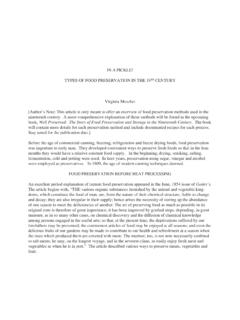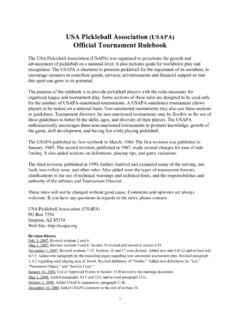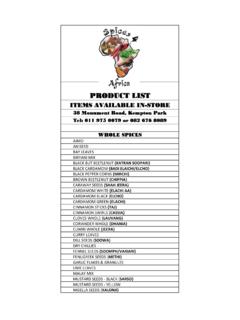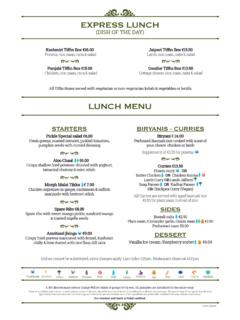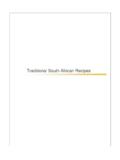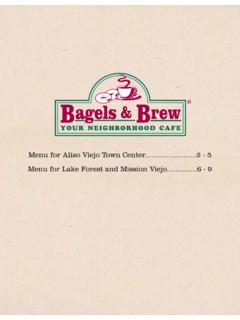Transcription of Spent Pickle Liquor (Spent Acid) - Hanna Steel
1 Spent Pickle Liquor ( Spent acid ). SDS. Section 1 Identification Identification Used on Label: Spent Pickle Liquor ( Spent acid ). Other names: Ferrous Chloride Solution., Waste Pickle Liquor , Waste acid , Ferrous Metal Pickling Recommended Use: None Name, Address, and Telephone Number: Hanna Steel Corporation Phone number : (800)633-8252 (8:00 am to 5:00 pm). 4527 Southlake Pkwy FAX: (205)820-5200. Hoover, AL 35244. Emergency Phone Number: 1-800-262-8200 (CHEMTREC). Section 2 Hazard(s) Identification Classification of the Chemical: Ferrous Chloride Solution is considered a hazardous material according to the criteria specified in REACH. [REGULATION (EC) No 1907/2006] and CLP [REGULATION (EC) No 1272/2008] and OSHA 29 CFR Hazard Communication Standard.
2 The categories of Health Hazards as defined in GLOBALLY HARMONIZED SYSTEM OF CLASSIFICATION. AND LABELING OF CHEMICALS (GHS), Third revised edition ST/ 3 United Nations, New York and Geneva, 2009 have been evaluated. Refer to Section 3, 8 and 11 for additional information. Signal Word, Hazard Statement(s), Symbols and Precautionary Statement(s): Hazard Hazard Classification Signal Word Hazard Statement(s) Precautionary Statement(s). Symbol Wear protective gloves / eye protection / face protection. Eye Irritation - 1 Wash thoroughly after handling. Causes severe eye damage. Do not eat, drink or smoke when using this product. If in eyes: Rinse with water for 20 minutes. Remove contact Danger Causes skin irritation.
3 Lenses and continue rinsing. Skin Irritation 2. If on skin: Rinse with water. If skin irritation occurs: Get Acute Toxicity Oral - 4 Harmful if swallowed. medical advice/attention. Take off contaminated clothing If swallowed: Rinse Mouth. Call a poison center or doctor if symptoms of illness develop. Hazards Not Otherwise Classified: None Known Unknown Acute Toxicity Statement (mixture): None Known Section 3 Composition/Information on Ingredients Chemical Name, Common Name (Synonyms), CAS Number and Other Identifiers, and Concentration:: Chemical Name CAS Number EC Number % Volume Ferrous Chloride 7758-94-3 231-843-4 14 - 28. Hydrochloric acid 7647-01-0 231-595-7 5 - 12. Water 7732-18-5 231-791-2 60 - 80.
4 EC- European Community CAS- Chemical Abstract Service Page 1 of 6 Rev. 5/15. Spent Pickle Liquor Section 4 First-Aid Measures Description of Necessary Measures: Inhalation: If inhaled: Remove person to fresh air and keep comfortable for breathing. Eye Contact: If in eyes: Rinse with water for 20 minutes. Remove contact lenses. Continue rinsing Skin Contact: If on skin: Wash with water. If skin irritation occurs: Get medical advice/attention. Take off contaminated clothing. Ingestion: If swallowed: Call a poison center or doctor/physician if you feel unwell. Rinse mouth. Do NOT induce vomiting. Most Important Symptoms/Effects, Acute and Delayed (Chronic): Acute Effects: Inhalation: May cause damage to respiratory tract with inhalation.
5 Eye: Causes serious eye damage. Skin: Exposure may cause skin burns. Ingestion: Causes damage to gastrointestinal tracts with oral exposures. Causes damage to cardiovascular system following oral exposure. Chronic Effects: Individuals with chronic respiratory disorders ( , asthma, chronic bronchitis, emphysema, etc.) may be adversely affected by low level exposures. Persons with pre-existing skin disorders may be more susceptible to dermatitis. 4(c) Immediate Medical Attention and Special Treatment: Treat symptomatically. Section 5 Fire-fighting Measures Suitable (and unsuitable) Extinguishing Media: Use extinguishers appropriate for surrounding materials. Specific Hazards Arising from the Chemical: Hydrogen chloride fumes may form during firefighting.
6 Special Protective Equipment and Precautions for Fire-fighters: Self-contained NIOSH approved respiratory protection and full protective clothing should be worn when fumes and/or smoke from fire are present. Heat and flames cause emittance of acidic smoke and fumes. Do not release runoff from fire control methods to sewers or waterways. Firefighters should wear full face-piece, self-contained breathing apparatus and chemical protective clothing with thermal protection. Direct water stream will scatter and spread flames and should not be used. Section 6 - Accidental Release Measures Personal Precautions, Protective Equipment and Emergency Procedures: For spills, personnel should be protected against contact with eyes and skin and avoid inhalation of vapor/mist.
7 Do not release into sewers or waterways. Collect material in appropriate, labeled containers for recovery or disposal in accordance with Federal, state, and local regulations. Methods and Materials for Containment and Clean Up: Collect material in appropriate, labeled containers for recovery or disposal in accordance with federal, state, and local regulations. Follow applicable OSHA regulations (29 CFR ) and all other pertinent state and federal requirements. Section 7 - Handling and Storage Precautions for Safe Handling: Wear protective gloves / eye protection / face protection. Wash thoroughly after handling. Do not eat, drink or smoke when using this product. Emergency safety showers and eye wash stations should be present in every location where this material could come in contact with any part of the body.
8 Conditions for Safe Storage, Including any Incompatibilities: Store away from incompatible materials. Section 8 - Exposure Controls / Personal Protection Occupational Exposure Limits (OELs):.The following exposure limits are offered as reference Ingredients OSHA PEL 1 ACGIH TLV 2 NIOSH REL 3 IDLH 4. Ferrous Chloride 10 mg/m (as iron oxide fume) mg/m (as iron salts (soluble, as Fe) mg/m (as iron NE. salts (soluble, as Hydrochloric acid C ppm C ppm Fe). C ppm 50 ppm NE - None Established 1. OSHA PELs (Permissible Exposure Limits) are 8-hour TWA (time-weighted average) concentrations unless otherwise noted. A ( C ) designation denotes a ceiling limit, which should not be exceeded during any part of the working exposure unless otherwise noted.))
9 An Action level (AL) is used by OSHA and NIOSH to express a health or physical hazard. They indicate the level of a harmful or toxic substance/activity, which requires medical surveillance, increased industrial hygiene monitoring, or biological monitoring. Action Levels are generally set at one half of the PEL but the actual level may vary from standard to standard. The intent is to identify a level at which the vast majority of randomly sampled exposures will be below the PEL. 2. Threshold Limit Values (TLV) established by the American Conference of Governmental Industrial Hygienists (ACGIH) are 8-hour TWA concentrations unless otherwise noted. ACGIH TLVs are for guideline purposes only and as such are not legal, regulatory limits for compliance purposes.
10 A Short Term Exposure Limit (STEL) is defined as the maximum concentration to which workers can be exposed for a short period of time (15 minutes) for only four times throughout the day with at least one hour between exposures. 3. The National Institute for Occupational Safety and Health Recommended Exposure Limits (NIOSH-REL) - Compendium of Policy and Statements. NIOSH, Cincinnati, OH (1992). NIOSH. is the federal agency designated to conduct research relative to occupational safety and health. As is the case with ACGIH TLVs, NIOSH RELs are for guideline purposes only and as such are not legal, regulatory limits for compliance purposes. Page 2 of 6 Rev. 5/15. Spent Pickle Liquor Section 8 - Exposure Controls / Personal Protection (continued).

